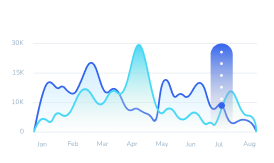Anticipate and prevent system attacks from the most sophisticated adversaries with AppSecure’s
offensive security stance. Discover critical exploitable vulnerabilities and continuously patch them
with our advanced security solutions.
Our expert team, made up of top bug bounty hunters from Fortune 500 companies, simulates real-world attacks to identify precarious gaps in your security perimeter with our unique, robust offensive techniques.










Continuously fortify your security posture and uncover concealed
vulnerabilities from a hacker’s perspective
Evaluate the efficacy of your security team’s readiness posture, detection, and response measures to tenacious hacker attacks on your network’s susceptible pathways.
Identify and redress the key security lapses with our balanced approach that tests your APIs in accordance with the OWASP paradigm, along with tailored test cases for preventing any recurrences.
Enhance your product’s security by proactively addressing potential threats arising from business logic vulnerabilities, CVE exploits, and adherence to the OWASP Top 10 security risks.
Protect you against the latest security threats using a range of security techniques including encryption, authentication, DDoS prevention, intrusion detection, vulnerability analysis, and real-time monitoring.
Continuously pen test to meet all the regulatory requirements for SOC2, ISO, and GDPR.
Continuously pen test to meet all the regulatory requirements for SOC2, ISO, and GDPR.
Outpace your attackers by identifying and closing critical blind spots in your production environment.
Outpace your attackers by identifying and closing critical blind spots in your production environment.
Research-intensive vulnerability assessment and penetration testing that mimics real-world attacker tools to uncover all exposures.
Research-intensive vulnerability assessment and penetration testing that mimics real-world attacker tools to uncover all exposures.
Proactive offensive security that guarantees complete detection and remediation of exploitable vulnerabilities
Proactive offensive security that guarantees complete detection and remediation of exploitable vulnerabilities
Leverage the expertise of leading ethical security professionals for result-oriented penetration testing.
Leverage the expertise of leading ethical security professionals for result-oriented penetration testing.
On-the-go redressal and extensive support to ensure zero security lapses.
On-the-go redressal and extensive support to ensure zero security lapses.
With the cybersecurity landscape in constant flux, it can be intimidating to keep up with the dynamic changes and the methods to ensure security compliance.


Learn what our clients have to say about our work

It has been our pleasure to work with AppSecure because they make security a hassle-free process. The security team at AppSecure not only finds security loopholes but also provides detailed action plans to fix the vulnerabilities found in the system. The team members are highly passionate and show great support during the process. I definitely recommend AppSecure to anyone looking to up their
security partners.

ClearTax have been working with AppSecure for a while now. The team at AppSecure has been the best security team we have worked with: they are diligent with testing, go the extra mile to explain any potential problems, and work closely with our engineering team to get issues resolved. AppSecure has been instrumental in making ClearTax more secure, and I will highly recommend them to any company that takes security seriously.

We have been working with AppSecure for 1 Year now and the team has helped us to make sure that our security is never compromised. They do the testing very meticulously, and provide detailed reports and helps to make sure that the issues have been resolved. They patiently listens to all the needs and guides you appropriately through each vulnerability assessment and their remedial procedures. We highly recommend AppSecure for all security related services for products on web or mobile at scale.

We have been relying on AppSecure Security to complement our in house red team to pentest many of our product releases, from UI components to API systems. I have been impressed with AppSecure.in team’s deep expertise on the OWASP areas, and the team does quite a thorough job on each of the engagements and provide detailed and timely reports. The team is also very flexible to learn about new technologies quickly to do a great job pentesting in spite of limited documentation. I would recommend them to any team looking for additional capacity and expertise in pentesting.

Appsecure has a great bunch of folks! They pointed out a bunch of medium to high and critical vulnerabilities, helping us meet our compliance goals and making our applications and APIs more secure. This also ensured that we are at par with OWASP ASVS 4.0, thus opening the door for a lot of business-critical partnerships. Their team worked patiently with us, revalidating each of the fixes when requested, aligning with our product release timelines. Competitive pricing is definitely the icing on the cake. Highly recommend them for VAPT!

We’ve worked with AppSecure across multiple projects for over a year. Their security reviews were extremely thorough, the explanation of the vulnerabilities they found was detailed, and they always provided great action plans to address the issues. They gave great feedback that improved the security of our products immensely and allowed us to focus on product development while we knew the security of our clients was in great hands.

AppSecure is like our extended security team. The AppSecure team is very patient in pointing out the non-trivial security bugs in our systems. They provide a thorough description of the steps to reproduce the bugs and they recommend remediations that are of the highest standards.
Understand the impact of our offensive testing approach on our clients’ defenses through our library of case studies.

Lorem Ipsum is simply dummy text of the printing and typesetting industry. Lorem Ipsum has been the industry’s standard dummy text ever since the when an unknown printer took a galley of type and scrambled it to make a type specimen book.
We have received your request, We’ll get back to you in less than 24hours